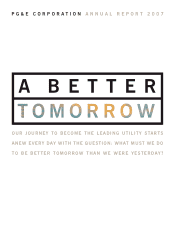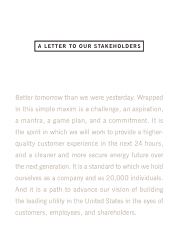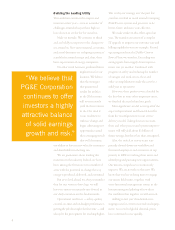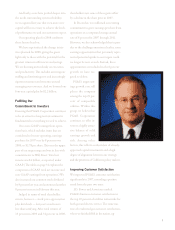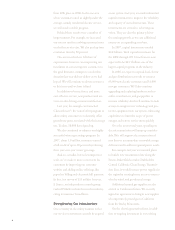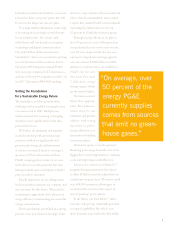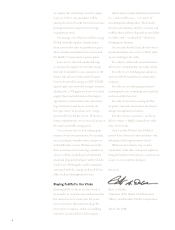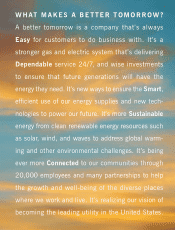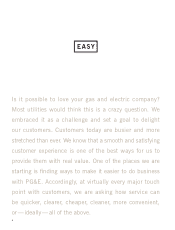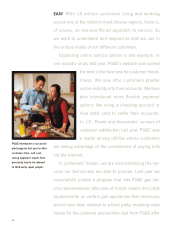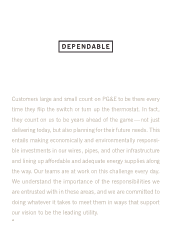PG&E 2007 Annual Report Download - page 6
Download and view the complete annual report
Please find page 6 of the 2007 PG&E annual report below. You can navigate through the pages in the report by either clicking on the pages listed below, or by using the keyword search tool below to find specific information within the annual report.4
from 20th place in 2006. In the one area
where customers rated us slightly under the
average, namely residential electric service,
we still made notable progress.
Behind these results were a number of
improvements. For example, we increased
our success rate for resolving customer issues
on the rst service visit. We also sped up issue
resolution times by 50 percent.
One area in which we fell short of
expectations, however, was improving our
timeliness in connecting new customers to
the grid. Intensive attempts to resolve this
situation last year did not deliver as we had
hoped. We will continue to devote resources
to this issue until we have it xed.
In addition to better, faster, and more
cost-e ective service, new products and ser-
vices are also driving customer satisfaction.
Last year, for example, we launched
ClimateSmartTM, the nation’s rst program to
allow utility customers to voluntarily o set
greenhouse gases associated with their energy
use. To date, 18,000 have signed up.
We also continued to enhance our highly
successful winter gas savings program. In
2007, about 1.9 million customers earned
a bill credit of up to 20 percent by reducing
their year-over-year winter gas usage.
And on a smaller, but no less important
scale, we’ve made it more convenient for
customers by improving our customer
website and adding online o erings like
paperless billing and electronic bill payment.
In fact, in a survey of 111 utilities last year,
E Source, an independent research group,
ranked PG&E’s website best in the industry,
citing its customer friendliness.
Strengthening Our Infrastructure
One certainty in the utility business is that
our service to customers can only be as good
as our system. Last year, we made substantial
capital investments to improve the reliability
and capacity of our infrastructure. ese
investments are critical to achieving our
vision. ey are also the primary driver
for earnings growth, as we earn additional
returns on an expanding asset base.
In 2007, capital investments totaled
$2.8 billion. Total capital investment for
the 2008 through 2011 time frame is now
expected to be $13.5 billion, one of the
largest capital programs in the industry.
In 2008, we expect to expand local electric
and gas distribution networks to connect
65,000 new electric customers and 51,000
new gas customers. We’ll also continue
upgrading and replacing hardware such as
cables, transformers, and gas pipeline to
increase reliability. And we’ll continue to look
at ways to integrate new technology and pro-
tective equipment into our system, enhancing
capabilities to limit the scope of power
outages and restore service more quickly.
Over the next several years, spending on
electric transmission will ramp up consider-
ably. is will support the construction of
new lines to accommodate renewable energy
deliveries and to address regional power needs.
For example, last year we unveiled plans
to build a new transmission line along the
Fresno-Bakers eld corridor. Dubbed the
Central California Clean Energy Transmis-
sion Line, it would increase power supplies in
the region by creating better access to sources
of solar, wind, and geothermal energy.
Additional natural gas supplies are also
critical to California’s future. We recently
signed an agreement to bring in new supplies
of competitively priced gas to California
from the Rocky Mountains.
On the electric generation front, in addi-
tion to ongoing investment in our existing

